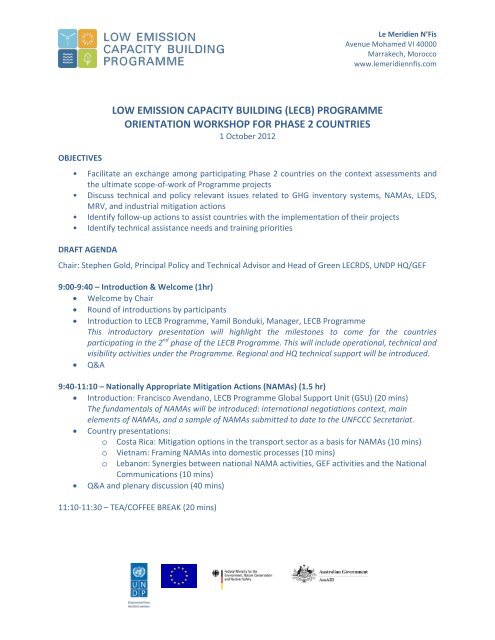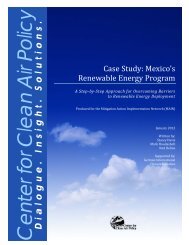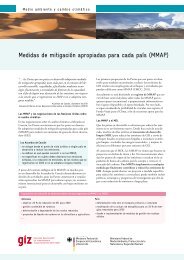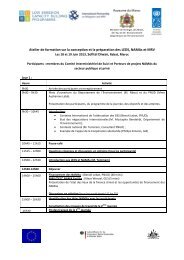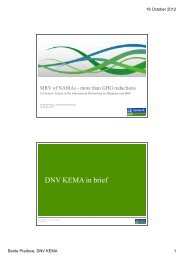(lecb) programme orientation workshop for phase 2 countries
(lecb) programme orientation workshop for phase 2 countries
(lecb) programme orientation workshop for phase 2 countries
You also want an ePaper? Increase the reach of your titles
YUMPU automatically turns print PDFs into web optimized ePapers that Google loves.
Le Meridien N’Fis<br />
Avenue Mohamed VI 40000<br />
Marrakech, Morocco<br />
www.lemeridiennfis.com<br />
OBJECTIVES<br />
LOW EMISSION CAPACITY BUILDING (LECB) PROGRAMME<br />
ORIENTATION WORKSHOP FOR PHASE 2 COUNTRIES<br />
1 October 2012<br />
• Facilitate an exchange among participating Phase 2 <strong>countries</strong> on the context assessments and<br />
the ultimate scope-of-work of Programme projects<br />
• Discuss technical and policy relevant issues related to GHG inventory systems, NAMAs, LEDS,<br />
MRV, and industrial mitigation actions<br />
• Identify follow-up actions to assist <strong>countries</strong> with the implementation of their projects<br />
• Identify technical assistance needs and training priorities<br />
DRAFT AGENDA<br />
Chair: Stephen Gold, Principal Policy and Technical Advisor and Head of Green LECRDS, UNDP HQ/GEF<br />
9:00-9:40 – Introduction & Welcome (1hr)<br />
• Welcome by Chair<br />
• Round of introductions by participants<br />
• Introduction to LECB Programme, Yamil Bonduki, Manager, LECB Programme<br />
This introductory presentation will highlight the milestones to come <strong>for</strong> the <strong>countries</strong><br />
participating in the 2 nd <strong>phase</strong> of the LECB Programme. This will include operational, technical and<br />
visibility activities under the Programme. Regional and HQ technical support will be introduced.<br />
• Q&A<br />
9:40-11:10 – Nationally Appropriate Mitigation Actions (NAMAs) (1.5 hr)<br />
• Introduction: Francisco Avendano, LECB Programme Global Support Unit (GSU) (20 mins)<br />
The fundamentals of NAMAs will be introduced: international negotiations context, main<br />
elements of NAMAs, and a sample of NAMAs submitted to date to the UNFCCC Secretariat.<br />
• Country presentations:<br />
o Costa Rica: Mitigation options in the transport sector as a basis <strong>for</strong> NAMAs (10 mins)<br />
o<br />
o<br />
Vietnam: Framing NAMAs into domestic processes (10 mins)<br />
Lebanon: Synergies between national NAMA activities, GEF activities and the National<br />
Communications (10 mins)<br />
• Q&A and plenary discussion (40 mins)<br />
11:10-11:30 – TEA/COFFEE BREAK (20 mins)
11:30-1:00 – Low Emission Development Strategies (LEDS) (1.5 hr)<br />
• Introduction: Rebecca Carman, LECB Programme GSU (20 mins)<br />
The fundamentals of LEDS and how they may frame NAMAs will be introduced.<br />
• Country presentations:<br />
o Moldova: LEDS and policy processes (10 mins)<br />
o Bhutan: Using LEDS to make NAMAs nationally appropriate (10 mins)<br />
o Tanzania: The role of LEDS in broader development ef<strong>for</strong>ts (10 mins)<br />
• Q&A and plenary discussion (40 mins)<br />
1:00-2:15 – LUNCH (1.25 hr)<br />
2:15-3:45 – National GHG Inventory Systems/Measuring, Reporting & Verification (MRV) (1.5 hr)<br />
• Introduction: Yamil Bonduki, LECB Programme GSU (20 mins)<br />
The MRV requirements of NAMAs will be introduced. The fundamentals of MRV systems<br />
including the importance of a GHG national inventory system will be presented.<br />
• Country presentations:<br />
o Ghana: GHG inventory systems as a basis <strong>for</strong> MRV work (10 mins)<br />
o Thailand: Domestic ef<strong>for</strong>ts on MRV systems (10 mins)<br />
o Trinidad and Tobago: GHG Inventory systems <strong>for</strong> the Oil & Gas Industry (10 mins)<br />
• Q&A and plenary discussion (40 mins)<br />
3:45-4:00 – TEA/COFFEE BREAK (15 mins)<br />
4:00 – 5:00 – Industry (1hr)<br />
• Introduction: Francisco Avendano, LECB Programme GSU (10 mins)<br />
The increasing role of industry in mitigation ef<strong>for</strong>ts will be introduced. The relationship between<br />
<strong>for</strong>mer private sector action (e.g. CDM) and future programmatic NAMA approaches will be<br />
highlighted.<br />
• Country presentations:<br />
o Indonesia: to be discussed (10 mins)<br />
o Malaysia: to be discussed (10 mins)<br />
• Q&A and plenary discussion (30 mins)<br />
5:00-6:00 – Discussion groups/Wrap up (1hr)<br />
During a facilitated exercise, <strong>countries</strong> will split into 3 working groups to discuss technical assistance<br />
needs and training priorities. These discussions will last <strong>for</strong> 40 minutes and will lay the groundwork <strong>for</strong><br />
follow-up support and actions from the GSU. Following the discussions, the working groups will present<br />
their main points to the plenary. Given the importance of ensuring Phase 2 national projects are<br />
underway by January 2013, should time permit, there will be a brief discussion on overcoming<br />
preparatory <strong>phase</strong> bottlenecks that may slow the initial implementation process.
Le Meridien N’Fis<br />
Avenue Mohamed VI 40000<br />
Marrakech, Morocco<br />
LOW EMISSION CAPACITY BUILDING (LECB) PROGRAMME<br />
TECHNICAL WORKSHOP<br />
DRAFT AGENDA<br />
2-4 October 2012<br />
OBJECTIVES<br />
• Kick start detailed technical work in reference and baseline scenarios as a basis <strong>for</strong> shaping<br />
NAMAs and LEDS.<br />
• Facilitate an exchange of learning among LECB <strong>countries</strong> on the various Programme outputs<br />
• Discuss technical and policy relevant issues related to baseline and mitigation scenarios, NAMAs,<br />
LEDS and MRV systems<br />
• Identify follow-up actions to assist <strong>countries</strong> with the implementation of their projects<br />
• Identify technical assistance needs and training priorities<br />
DAY 1, Tuesday, 2 October<br />
9:00-9:45 Session 1: Welcome & Introduction<br />
09:00 – 09:15 Welcome EC (tbc)<br />
UNDP<br />
09:15 – 09:30 Round of introduction Plenary<br />
by participants<br />
Welcome to participants and thanks to the host<br />
country<br />
Name and institutional affiliation of each participant<br />
09:30 –09:45 Agenda and <strong>workshop</strong><br />
expectations<br />
Rebecca<br />
Carman, UNDP<br />
The main activities and desired outcomes of the<br />
<strong>workshop</strong> will be highlighted<br />
09:45- 12:30 Session 2: Reference and Mitigation Scenarios<br />
09:45–10:05 Presentation:<br />
Introduction to<br />
Reference and Mitigation<br />
Scenarios (20 mins)<br />
10:05-10:30 Plenary discussion (25<br />
mins)<br />
10:30-11:00 Tea/coffee break<br />
11:00-11:30 Presentation: Crafting<br />
Reference Scenarios at<br />
the Country Level using<br />
LEAP (30 mins)<br />
Francisco<br />
Avendano,<br />
UNDP<br />
Plenary<br />
Charles Heaps,<br />
SEI<br />
11:30-11:40 Questions <strong>for</strong> clarification Plenary<br />
The Global Support Unit will present the role of<br />
reference and mitigation scenarios in shaping NAMAs<br />
and LEDS, and briefly highlight the ongoing work on<br />
scenarios development <strong>for</strong> the 25 <strong>countries</strong><br />
participating in the LECB Programme. Particular<br />
attention will be given to the pros and cons of national<br />
vs sectoral scenarios<br />
The Stockholm Environment Institute (SEI) has<br />
developed first cut reference scenarios <strong>for</strong> LECB<br />
<strong>countries</strong>. SEI will present the process it has followed,<br />
assumptions and methodology to develop the<br />
scenarios
11:40-12:30 Plenary discussion: Use of<br />
Scenarios <strong>for</strong><br />
Understanding Country<br />
Dynamics and Emissions<br />
(50 mins)<br />
SEI, UNDP<br />
12:30 – 14:00 Lunch<br />
14:00-16:00 Session 3: LEAP applications & training<br />
14:00-14:20 Presentation: LEAP SEI<br />
Applications at the Sector<br />
Level (20 mins)<br />
14:20 – 14:30 Questions <strong>for</strong> clarification Plenary<br />
14:30 – 14:45 Presentation: Malaysia Malaysia (tbc)<br />
(15 mins)<br />
14:45 – 15:00 Presentation: Moldova Moldova (tbc)<br />
(15 mins)<br />
15:00 – 15:10 Questions <strong>for</strong> clarification Plenary<br />
15:10-16:00 Plenary discussion<br />
16:00 –16:30 Coffee/tea break<br />
SEI and UNDP will facilitate a plenary discussion where<br />
<strong>countries</strong> will discuss the role of scenarios in climate<br />
change mitigation. Political vs technical prioritization<br />
of sectors and NAMAs will be discussed.<br />
SEI will present the methodology and process followed<br />
to craft scenarios <strong>for</strong> prioritized sectors: Transport<br />
(Costa Rica)<br />
Use of LEAP to model sectoral reference and<br />
mitigation scenarios: country experience<br />
Use of LEAP to model sectoral reference and<br />
mitigation scenarios: country experience<br />
16:30-17:30 Session 4: Moving From Scenarios to LEDS and NAMAs<br />
16:30-17:30 Panel Discussion: Moving<br />
From Scenarios to NAMAs<br />
(60 mins)<br />
Peru, Kenya<br />
and Indonesia<br />
(tbc)<br />
Besides LEAP, other standard and ad-hoc plat<strong>for</strong>ms are<br />
being used to develop scenarios and envision low<br />
carbon development paths. The panel <strong>countries</strong> will<br />
talk about their lessons to date in a moderated<br />
discussion that also includes questions from the<br />
plenary.<br />
DAY 2, Wednesday, 3 October<br />
09:00 – 10.45 Session 5: Designing NAMAs<br />
09:00 – 09:30 A comparable approach to<br />
NAMAs: Using the NAMA<br />
Design Document (NDD)<br />
to craft NAMA proposals<br />
(30 mins)<br />
Francisco<br />
Avendano,<br />
UNDP<br />
The NAMA Design Document (NDD) and the process to<br />
structure NAMAs using this template will be<br />
introduced. Basic <strong>orientation</strong> will be provided to fill<br />
each section of the document based on the outcome of<br />
decision support tools. Countries will have a webinar<br />
prior to the <strong>workshop</strong> to be introduced to the<br />
fundamentals of NAMAs.<br />
09:30 – 09:40 Questions <strong>for</strong> clarification Plenary<br />
(10 mins)<br />
09:40 – 10:00 Introduction to the<br />
UNFCCC Prototype NAMA<br />
UNFCCC The UNFCCC NAMA Registry Prototype will be<br />
presented<br />
registry (20 mins)<br />
10:00 – 10:45 Plenary discussion (45 Plenary<br />
mins)<br />
10:45 – 11:15 Tea/coffee break<br />
11:15 – 12:30 Session 6: Embedding MRV compliance within NAMAs design<br />
11:15 – 11:45 Presentation: MRV<br />
requirements and<br />
considerations <strong>for</strong> NAMAs<br />
design (30 mins)<br />
Kimberly<br />
Todd, UN-<br />
REDD<br />
Measurement, Reporting and Verification aspects of<br />
NAMAs<br />
4
11:45 – 12:30 Plenary discussion (45<br />
mins)<br />
12:30 – 13:30 Lunch<br />
14:00-17:30 Session 6: Embedding MRV compliance within NAMAs design (cont.)<br />
13:30-13:50 Presentation: Country<br />
case study (20 mins)<br />
Mexico (tbc) How Mexico is embedding key MRV elements of<br />
NAMAs into its institutional framework<br />
13:50-14:00 Questions <strong>for</strong> clarification<br />
(10 mins)<br />
14:00-15:30 NAMA Design Document<br />
(NDD) Group Exercise (90<br />
mins)<br />
Working<br />
groups<br />
Participants will be divided into working groups to<br />
complete a basic NAMA Design Document <strong>for</strong> a case<br />
study provided to the participants.<br />
Tea/Coffee break<br />
15:30 – 16:00 Plenary discussion (30<br />
mins)<br />
16:00-16:20 Sector and activity<br />
oriented MRV systems:<br />
cement industry (20 mins)<br />
16:20-16:30 Questions <strong>for</strong> clarification<br />
(10 mins)<br />
16:30-16:50 Presentation: Country<br />
case study<br />
16:50 – 17:00 Questions <strong>for</strong> clarification<br />
(10 mins)<br />
17:00-17:30 Plenary discussion (30<br />
mins)<br />
WBCSD (tbc)<br />
China (tbc)<br />
Plenary<br />
Tea & coffee can be collected and taken into the<br />
working groups<br />
Specific examples of approaches to sectoral MRV will<br />
be introduced: cement<br />
How China is developing low-carbon product<br />
certification standards<br />
DAY 3, Thursday, 4 October<br />
09:00-13:30 Session 7: From NAMA design to implementation: south-south knowledge exchange<br />
09:00-09:20 Presentation: Country<br />
(20 mins)<br />
Morocco (tbc) Presentation of an actual NAMA under<br />
development, including challenges & lessons learned<br />
09:20-09:45 Plenary discussion & Q&A Plenary<br />
(25 mins)<br />
09:45-10:05 Presentation: Country<br />
(20 mins)<br />
Colombia (tbc) Presentation of an actual NAMA under<br />
development, including challenges & lessons learned<br />
10:05-10:30 Plenary discussion & Q&A Plenary<br />
(25 mins)<br />
10:30-11:00 Tea/coffee break<br />
11:00-11:20 Presentation: Country<br />
(20 mins)<br />
Chile (tbc) Presentation of an actual NAMA under<br />
development, including challenges & lessons learned<br />
11:20-11:45 Plenary discussion & Q&A<br />
(25 mins)<br />
Plenary<br />
5
11:45 – 13:00 Working group<br />
discussions (75 mins)<br />
Working groups<br />
Building on the presentations of the morning,<br />
working groups will discuss various aspects of<br />
NAMAs and MRV. Questions may include:<br />
• How are we incorporating MRV considerations<br />
into the design of our NAMAs<br />
• What are the greatest challenges<br />
• What are our most promising NAMAs, and<br />
why What are the most promising elements of<br />
these NAMAs in terms of attracting financial<br />
support<br />
• What other mitigation activities are we<br />
undertaking that could be framed as NAMAs<br />
• Where are our greatest capacity needs<br />
Working groups report back on 3 key points per<br />
group. Brief plenary discussion.<br />
13:00-13:30 Plenary discussion (30<br />
mins)<br />
13:30-14:30 Lunch<br />
14:30-16:00 Session 7: From NAMA design to implementation: south-south knowledge exchange (cont)<br />
14:30-14:50 Presentation: Investor Ghana<br />
Presentation on an investor guide developed <strong>for</strong><br />
Guide <strong>for</strong> NAMAs<br />
Ghana<br />
14:50-15:15 Plenary discussion & Q&A<br />
(25 mins)<br />
15:15-15:35 Presentation: Putting in Philippines Presentation on how the government has structured<br />
Place an Institutional<br />
its institutional framework to respond to climate<br />
Framework <strong>for</strong> NAMAs<br />
change and how this will assist in NAMA design.<br />
15:35-16:00 Plenary discussion & Q&A<br />
(25 mins)<br />
16:00-16:30 Tea/coffee break<br />
16:30-18:00 Session 8: Next Steps & Closing Remarks<br />
16:30 – 17:15 Panel Discussion:<br />
Financing opportunities<br />
<strong>for</strong> NAMAs (45 mins)<br />
17:15-17:45 Plenary discussion: Next<br />
Steps (30 mins)<br />
17:45-18:00 Thanks & closing remarks<br />
(15mins)<br />
EC, Germany,<br />
Australia (tbc)<br />
Plenary, chair<br />
Yamil Bonduki,<br />
UNDP<br />
Donors will present their main <strong>programme</strong>s that<br />
support developing <strong>countries</strong> on mitigation actions,<br />
including main criteria <strong>for</strong> funding<br />
This session would focus on what has been learned<br />
and what can be applied moving <strong>for</strong>ward.<br />
6


